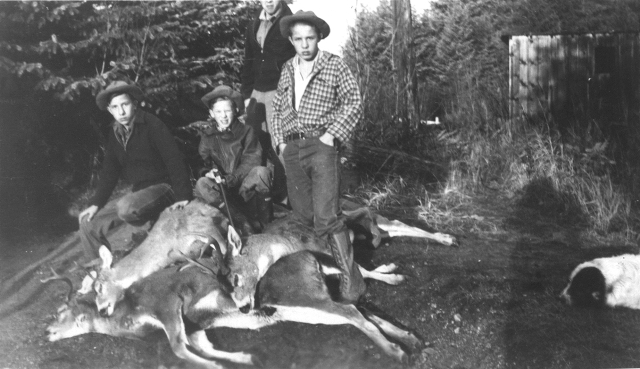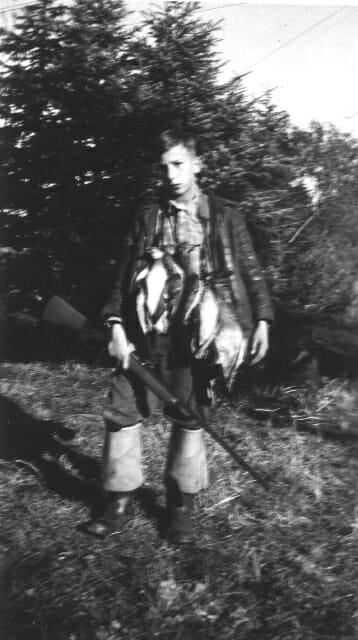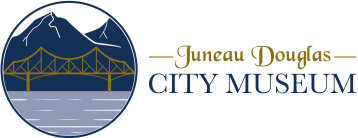Gastineau Channel Memories
Mielke, Max & Ella
Glen Mielke
My father, Max, was born and raised in Michigan and my mother, Ella Kunde, was born and raised in Wisconsin. Max and Ella came to Juneau in 1929. Arriving with parents were my three brothers, Bruce, age five, Ralph, four and Dave, three. I, Glen, was born in Juneau, August 4, 1930, in a home located on Third and Seward Streets. This home is now gone and a parking lot exists. I asked my dad why he came to Alaska. He said, ?It was getting too crowded where we lived.? From that location, our family moved to Eleventh Street and after a couple years we moved to the Mendenhall Valley. The first home in the valley was rented from Joe Kendler, dairy farmer, whose business was about a mile away.
As an energetic boy, I was hired to assist harvesting the hay for the cattle. Every summer in July, Mr. Kendler mowed the fields and after a week of drying, the hay was forked on to trucks and taken to the barn. This work was always done in July because the rain always came in August. My job was to pack the hay as it was being loaded on the truck. I was also dispenser of the lemonade that Mrs. Kendler produced for the workers.
Dad was a painter by trade. Upon arriving in Juneau, he established a contracting business. He was very busy in the summers but work slacked off during the winter. This created a financial situation: always running out of money. Dad became well known around town and credit was easily established. Run up a debt in the winter and pay it off in the summer.
During the 30?s and 40?s, the Mendenhall Valley was sparsely populated. The homes that were there were mostly fox and mink farms. There was no airport and very few cars. It was a very quiet, peaceful place to live. About the only sounds to be heard were cattle bellowing, owls hooting and occasionally the far off cry of a wolf or coyote. The valley was an outdoorsman?s paradise. All types of game; deer, mountain goats, bear, beaver, mink, otters, rabbits, ducks, geese, grouse and ptarmigan were seen and some hunted. The creeks were all full of salmon and trout. The Charlie Rudy family employed the Mielke boys to supply salmon for fox and mink feed. Cohos and sockeye were ten cents apiece and chums and pinks five cents each. This source of revenue supplied the cash for ammunition for hunting purposes. Our family grew up eating wild game. I could hardly wait to get home from school, get my shotgun or fishpole and get out into the woods. Mallard ducks were always present in the swamps and fields.
The finest trout fishing I ever experienced was in Fagerson?s pond across the road from Charlie Rudy?s fox and mink farm (now called Kodzoff #1). Charlie planted cutthroat in the pond so his adopted daughter, Mida, would have a place to fish when she got older. Mr. Rudy put a dead horse in the pond to develop beetles for trout feed. Prior to the building of the Juneau Airport, this pond was landlocked. About 1942, the U.S. Army developed the airport. At this time Duck Creek was diverted through this pond. For two years, during March and April, I hardly missed a day that I didn?t go fishing. The trout averaged ten to nineteen inches and I would catch two to ten each time I went there. I?d lay them on the snow and sometimes they were frozen before I got them home. Mida never did fish there, but I did.
From the rented home at Kendler?s, we moved across Duck Creek to where Grandma?s Featherbed now exists. This was home til I went into the U.S. Army in 1951.
In 1942, the U.S. Army had a camp in the Duck Creek area. The airport was developed and military aircraft landed here on the way north. The whole perimeter around the airport was protected by machine gun posts and sand bunkers for shielding aircraft. The hillside above Fred Meyers had machine gun posts that overlooked the airport and Mendenhall wetlands. The whole place was prepared for invasion. Blackouts were required at home and downtown Juneau had practice air raid warning alerts. School children had designated places to go. At Montana Creek, a basic training camp was established.
After the war ended, the valley went back to normal with very little activity. This situation continued until Statehood when the valley slowly started to develop.
Dad developed lead poisoning and found a different type of work. In the early 40?s, he went to work for the U.S. Forest Service as a trail maintenance foreman. I, and many young men, worked with him on jobs around Southeast Alaska. The Forest Service had a fleet of Ranger boats that transported the crews to different locations. Around 1950, this type of work ended and my dad then got a job with the FAA as a general maintenance mechanic and worked there until his retirement.
Mother died in Juneau on March 5, 1969, and Dad died on April 24, 1978, in Sequim, Washington, where brother Ralph is living. Brother Dave died in Juneau about 1987.
Over all these years, I?ve seen Juneau change from a mining community to what it is today. Juneau residents moved and expanded to the valley and beyond. Roads were improved and changed and extended. Then,two school buses were adequate for the Glacier Highway. Now there is a large fleet.
Growing up and living in the Mendenhall Valley is something I?m glad I didn?t miss. I still live here at Auke Bay with my wife Delia. We have four children. Three in Juneau and one in Haines, and seven grandchildren. I can?t think of a better place to live.
 |
|
 |
|
 |
|
